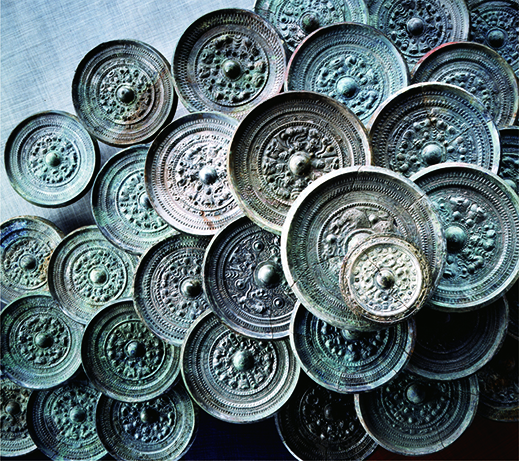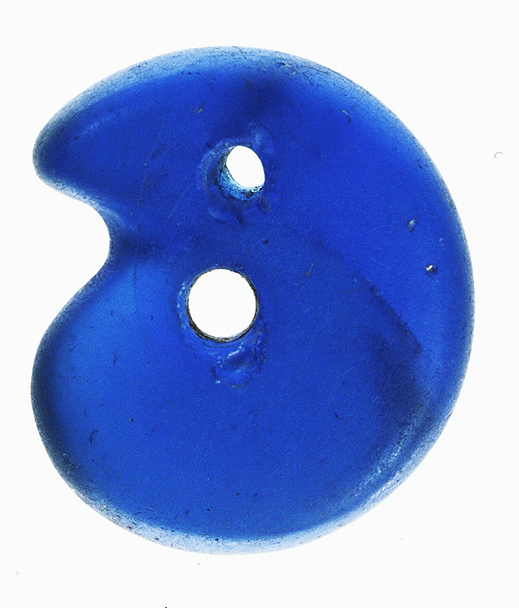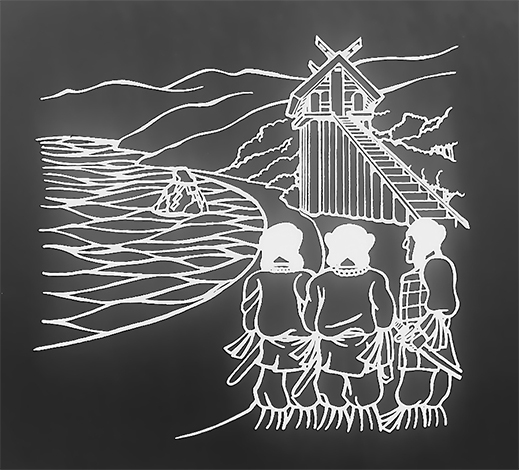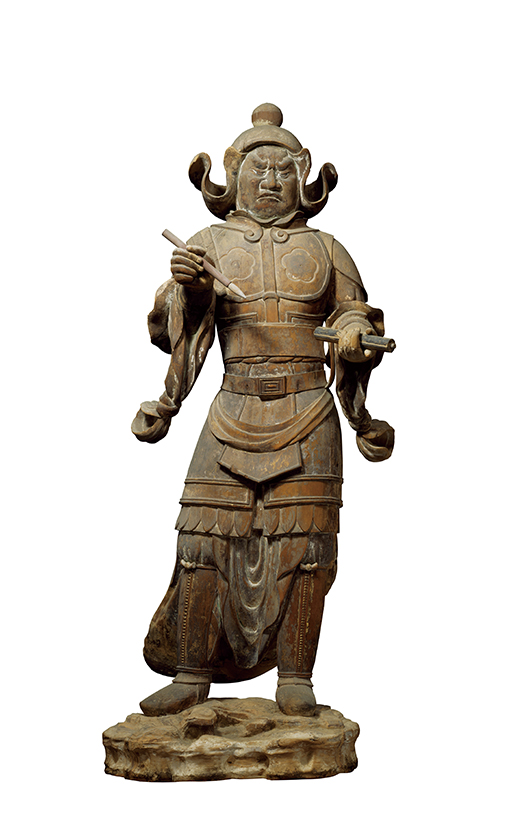 |
 |
 |
HOME > FOCUS > Seats of Power, Sacred and Sovereign: Tales Unearthed in Shimane and Nara |
 |
 |
Focus features two in-depth reviews each month of fine art, architecture and design exhibitions and events at art museums, galleries and alternative spaces around Japan. The contributors are non-Japanese residents of Japan. |
|
|
 |
 |
 |
Seats of Power, Sacred and Sovereign: Tales Unearthed in Shimane and Nara
Susan Rogers Chikuba |
 |
This rocky shrine on Inasa Beach, one kilometer due west of Izumo Shrine in Shimane Prefecture, figures in Japan's earliest legends as a site where gods gathered to hash out Important Things. (They still alight here, each fall.) It's good that mere mortals can sidle up so close. Photo by Susan Rogers Chikuba
|
"It was the ancient past, when the heavens and earth were unified. When the yin and the yang were still one. When nothing was yet fixed, when the void was yet dark, and all signs of what was to come were hidden within." So begins the first exhibit of Izumo and Yamato: The Birth of Ancient Japan, showing at the Tokyo National Museum through 8 March and organized by the present-day counterparts of those two old provinces, the prefectures of Shimane and Nara.
Nihon Shoki (The Chronicles of Japan; Important Cultural Property), volume 2, 1375-1377; Atsuta Shrine, Aichi. This 14th-century transcription* of the historical text compiled in 720 has notations that facilitate a Japanese reading of the classical Chinese. *Exhibited from 11 February. A still earlier copy, a National Treasure dated 1303, is displayed through 9 February. |
The quote is from the "Age of the Kami" scroll of Nihon Shoki (The Chronicles of Japan; 720), a literary monument that recounts the fabled origins of Japan and the reigns of its first 41 emperors. (And the translation is from the audio guide -- well worth renting, for 560 yen.) Together with Kojiki (Records of Ancient Matters; 712), it is the oldest written compilation of Japanese history. Both texts relate, though in varying accounts, the kuni-yuzuri legend at the heart of this show. In brief, it's a (politically motivated) tale about how rule of the land passed from the earthly gods of Izumo -- those who oversaw such practical matters as agriculture and fishing and medicine and commerce -- to the kami of the heavens and, eventually, to the imperial line. Scholars today understand it to be a mythical account of the process of state unification under the Yamato court at Nara, an early seat of centralized imperial power that emerged in the mid-3rd century.
 |
|
Bronze mirrors with design of Daoist immortals and animals and either sawtooth pattern on rim or patterned concentric bands, excavated from Kurozuka tumulus, Tenri, Nara, 3rd century; Agency for Cultural Affairs |
The gods of Izumo were thus given mandate over the invisible, supersensory realm of spirit, while Yamato would unify and govern the body politic, particularly through Buddhism after its introduction in the 6th century. Of course, in reality unification of the country was a long slow process of negotiation with powerful clans and, at times, military conquest. If it weren't for the remarkable way in which Japan managed to maintain and integrate its Shinto and Buddhist practices over the centuries, the shift from nature-centered worship to notions of redemption in the afterlife and divine protection attained by the patronage of state-sanctioned temples might have posed a much deeper rift. Presenting a stunning array of artifacts from the archaeological record and evidence of the exchanges that took place between the two distant provinces, the exhibition aims to show how Izumo and Yamato in fact maintained a balance of power as two quite different cultural spheres.
 |
|
Magatama comma-shaped glass bead, excavated from Nishidani tomb no. 3, Izumo, Shimane, 1st-3rd century; Department of Archaeology, Shimane University. Izumo province was a center of sacred bead making from the 3rd to the 12th centuries.
|
The show begins in a darkened gallery dedicated to Izumo Shrine, one of Japan's oldest Shinto sanctuaries and a place deeply tied to the country's creation myths. Its founding is addressed in both Kojiki and Nihon Shoki, but archaeological evidence suggests that it dates back still further, at least to the latter half of the 4th century. Ceremonial bronze vessels, swords and daggers, and glass magatama beads from prehistoric times (these last three -- a sword, dagger, and jewel -- are familiar as the Three Sacred Treasures of the imperial regalia) have been excavated from 2nd-century burial mounds around the Shimane Peninsula, suggesting that Izumo, which had a lively maritime trade, was a center of worship and cultural exchange with the continent long before its shrine came to be. Such artifacts are presented here and in the second gallery, which examines ancient rites and rituals characteristic of the province and influenced by its early exchanges with mainland Asia.
 |
|
Central pillar at front of inner sanctuary (Important Cultural Property), dated 1248, excavated in 2000 from Izumo Shrine, Shimane.
|
Proof of Izumo Shrine's religious authority lasting even into the 13th century was discovered in 2000, when the remains of giant pillars that once supported its inner sanctuary were excavated from the precincts. Each individual column (there were nine altogether) was formed by a trio of cedar logs bound together to form a single member three meters in circumference. Two of these are on display, thoughtfully installed to show the actual distance that stretched between them. Thread holes for rope indicate how the massive trunks were transported, while hatchet marks show evidence of the hands that shaped them, always a sobering thing in museum exhibits -- it's as if workers of centuries ago are reaching out to you from behind the glass. The adjacent room houses a 1:10 scale model of what the full structure, 48 meters high and complete with a ramp some 109 meters long, actually looked like in design.
 |
|
 |
|
|
|
Referencing an extant construction diagram as well as a 10th-century school primer, scholars hypothesize that the inner sanctuary, rebuilt in 1248, appeared as shown in this illustration (courtesy of Izumo city) and model (on exhibit).
|
The third gallery looks at the birth of the Yamato state in the 3rd century, providing historical context for the subsequent emergence of imperial authority. Early Yamato rulers acquired rare, high-status imports from the Korean Peninsula and China, which they used to win the allegiance of powerful clans in Japan. (Horse-tack fittings fashioned of gold and bronze and adeptly decorated in open work with the shapes of dragons, phoenixes, lions, and a fierce god holding a sword are just one stunning example.) At the same time Yamato gained a foothold in the East Asian political sphere and access to the latest metalworking advances, irrigation methods, and other technologies. Bracelets, rings, earrings, and beads of gold and silver and excavated from Nara's 5th-century burial mounds were the only ones of their kind in Japan at the time but are similar to those found at sites in the former Korean kingdoms of Silla (57 BCE-935) and Baekje (18 BCE-660). One of the most unusual items on display is the celebrated seven-branched sword mentioned in volume 9 of Nihon Shoki. Forged of iron with gold inlay, this National Treasure is believed to have been a gift of state from the Baekje kingdom, possibly to cement relations and consolidate power in a time of uncertainty on the Korean Peninsula.
 |
|
 |
|
|
|
Left: Komokuten (Virupaksa, King of the West) of the Four Heavenly Kings (National Treasure), 8th century; Toshodai-ji temple, Nara. Right: Jikokuten (Dhrtarastra, King of the East) of the Four Heavenly Kings (Important Cultural Treasure), 9th century; Manpuku-ji temple (Otera Yakushi), Shimane.
|
The fourth and last gallery addresses the spread of Buddhist beliefs from the imperial court to powerful families in the provinces from the latter half of the 7th century. By the early 8th century, Buddhist temples had been built across the country, replacing burial mounds as centers of political power and authority. Believing that devotion would be rewarded with divine national protection, the Yamato court also commissioned the carving of many Buddhist statues. The Four Heavenly Kings, protectors of the cardinal directions, were particularly revered as guardians of the state. As many as seven of them are on display. Still, on special occasions such as the enthronement of a new emperor, the head of Izumo's most powerful clan and a contingent of priests from the province's 180 shrines would travel to Yamato to intone prayers for longevity and the country's stability, a demonstration that the state also lay under the protection of the kami of Izumo.
 |
|
Bronze swords, ritual bells, halberds (National Treasures), excavated from Kojindani ruins, Izumo, Shimane, 2nd to 1st century BCE; Agency for Cultural Affairs
|
Until 9 February you can also visit the Man, God & Nature in the Ancient World exhibition next door in the museum's Toyokan building. Exquisite works by the hands of ancients from around the world, amassed by the late Sheikh Hamad bin Abdullah Al Thani of Qatar, also look at the big questions of divinity, power, and the afterlife, and what the world of animals and other spirits has to say about them.
Unless otherwise noted, all photos are courtesy of the Tokyo National Museum.
|
 |
 |
Susan Rogers Chikuba
Susan Rogers Chikuba, a Tokyo-based writer, editor and translator, has been following popular culture, architecture and design in Japan for three decades. She covers the country's travel, art, literary and culinary scenes for domestic and international publications. |
|
 |
|
|
 |
|
 |
|